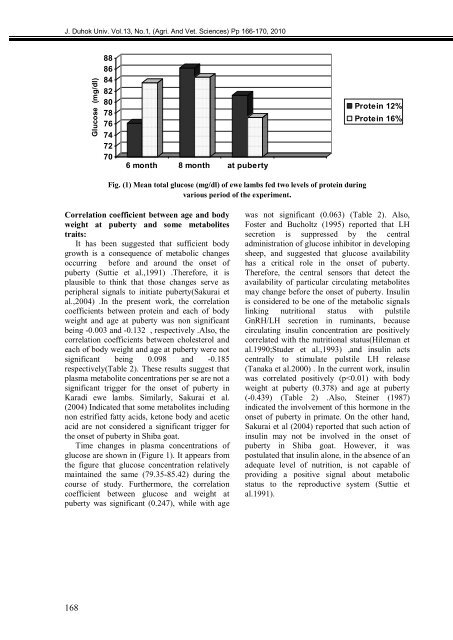The Influence Of Priming Two Cucumber Cultivar Seeds
The Influence Of Priming Two Cucumber Cultivar Seeds
The Influence Of Priming Two Cucumber Cultivar Seeds
Create successful ePaper yourself
Turn your PDF publications into a flip-book with our unique Google optimized e-Paper software.
J. Duhok Univ. Vol.13, No.1, (Agri. And Vet. Sciences) Pp 166-170, 2010<br />
168<br />
Glucose (mg/dl)<br />
88<br />
86<br />
84<br />
82<br />
80<br />
78<br />
76<br />
74<br />
72<br />
70<br />
6 month 8 month at puberty<br />
Fig. (1) Mean total glucose (mg/dl) of ewe lambs fed two levels of protein during<br />
various period of the experiment.<br />
Correlation coefficient between age and body<br />
weight at puberty and some metabolites<br />
traits:<br />
It has been suggested that sufficient body<br />
growth is a consequence of metabolic changes<br />
occurring before and around the onset of<br />
puberty (Suttie et al.,1991) .<strong>The</strong>refore, it is<br />
plausible to think that those changes serve as<br />
peripheral signals to initiate puberty(Sakurai et<br />
al.,2004) .In the present work, the correlation<br />
coefficients between protein and each of body<br />
weight and age at puberty was non significant<br />
being -0.003 and -0.132 , respectively .Also, the<br />
correlation coefficients between cholesterol and<br />
each of body weight and age at puberty were not<br />
significant being 0.098 and -0.185<br />
respectively(Table 2). <strong>The</strong>se results suggest that<br />
plasma metabolite concentrations per se are not a<br />
significant trigger for the onset of puberty in<br />
Karadi ewe lambs. Similarly, Sakurai et al.<br />
(2004) Indicated that some metabolites including<br />
non estrified fatty acids, ketone body and acetic<br />
acid are not considered a significant trigger for<br />
the onset of puberty in Shiba goat.<br />
Time changes in plasma concentrations of<br />
glucose are shown in (Figure 1). It appears from<br />
the figure that glucose concentration relatively<br />
maintained the same (79.35-85.42) during the<br />
course of study. Furthermore, the correlation<br />
coefficient between glucose and weight at<br />
puberty was significant (0.247), while with age<br />
Protein 12%<br />
Protein 16%<br />
was not significant (0.063) (Table 2). Also,<br />
Foster and Bucholtz (1995) reported that LH<br />
secretion is suppressed by the central<br />
administration of glucose inhibitor in developing<br />
sheep, and suggested that glucose availability<br />
has a critical role in the onset of puberty.<br />
<strong>The</strong>refore, the central sensors that detect the<br />
availability of particular circulating metabolites<br />
may change before the onset of puberty. Insulin<br />
is considered to be one of the metabolic signals<br />
linking nutritional status with pulstile<br />
GnRH/LH secretion in ruminants, because<br />
circulating insulin concentration are positively<br />
correlated with the nutritional status(Hileman et<br />
al.1990;Studer et al.,1993) ,and insulin acts<br />
centrally to stimulate pulstile LH release<br />
(Tanaka et al.2000) . In the current work, insulin<br />
was correlated positively (p



